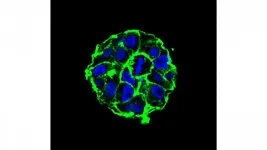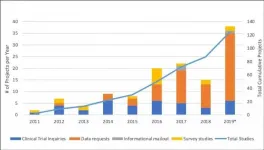Hydrogen-producing enzyme protects itself against oxygen
Biology
2021-02-02
(Press-News.org) An international research team from the Photobiotechnology Research Group at Ruhr-Universität Bochum (RUB) led by Professor Thomas Happe and the Laboratoire de Bioénergétique et Ingénierie des Protéines (CNRS) in Marseille has been able to get to the bottom of this unique feature. They describe the molecular mechanism in Nature Communications on 2 February 2021.
Enzyme repeatedly survives the attack unharmed
Representatives of the [FeFe]-hydrogenase enzyme group combine protons and electrons to form molecular hydrogen at particularly high turnover rates. Some of them even use sunlight as a primary energy source for this. However, even low oxygen concentrations quickly lead to the irreversible breakdown of the catalytic cofactor, called the H-cluster. "This has so far been observed in all representatives of this enzyme group - except for CbA5H. This enzyme has a molecular mechanism that allows it to repeatedly survive the oxygen attack unharmed," says Thomas Happe.
In collaboration with Professor Eckhard Hofmann, head of the Protein Crystallography group at RUB, the researchers discovered the enzyme's trick by analysing its crystal structure. "In the active enzyme, the open substrate binding site usually represents the primary point of attack for oxygen," explains Dr. Martin Winkler, one of the RUB researchers involved. In CbA5H, this normally accessible site is shielded under air: Under oxidative conditions the thiol group of a cysteine residue, which was already known for its involvement in proton mediation at the active site of [FeFe]-hydrogenases, binds directly to the free substrate coordination site of the catalytic 2FeH cluster. The point of access is thus blocked for oxygen as long as the ambient oxygen increases the redox potential.
As soon as oxygen is removed from the ambient gas mixture and the redox potential decreases, the thiol group is detached from the substrate binding site of the active site and the enzyme resumes its catalytic activity unharmed. "This hydrogenase can adopt the protected state repeatedly, unlike all other known [FeFe]-hydrogenases," explains Thomas Happe.
The difference from other enzymes
It was initially unclear why specifically CbA5H exhibits this protective function, while other very similar [FeFe]-hydrogenases, that also provide this cysteine residue in the same place as part of the proton mediation chain lack this important feature. A closer inspection of the crystal structure of CbA5H in the oxygen-protected state showed that the section of the protein chain carrying this cysteine is shifted towards the substrate binding site near the active cofactor. Compared with oxygen-sensitive [FeFe]-hydrogenases such as CpI from Clostridium pasteurianum, the researchers at RUB were able to identify three smaller amino acids in CbA5H near to the shifted section of polypeptide chain, which provide it with greater freedom of movement. Electrochemical and infrared spectroscopy examinations of protein variants with single and double exchanges in these positions confirmed the importance of these amino acids for the unique, potential-controlled molecular safety cap mechanism of CbA5H.
"As we now know the structural conditions of this protective mechanism, it should be possible to also transfer the advantageous property of oxygen resistance from CbA5H to other [FeFe]-hydrogenases," says Dr. Jifu Duan, another member of the Photobiotechnology Research Group. "If this is successful, we would be a major step towards using [FeFe]-hydrogenases as hydrogen biocatalysts," confirms Thomas Happe.
INFORMATION:
ELSE PRESS RELEASES FROM THIS DATE:
2021-02-02
DANVILLE, Pa. and GAITHERSBURG, Md. - Researchers have discovered a strong link between genetic changes known to cause neurodevelopmental disabilities and cerebral palsy.
Cerebral palsy affects movement and posture and often co-occurs with other neurodevelopmental disorders, including intellectual disability, epilepsy and autism spectrum disorder. Individual cases of cerebral palsy are often attributed to birth asphyxia, although recent studies indicate that asphyxia accounts for less than 10% of cases. A growing body of research indicates that cerebral palsy may be caused by genetic changes, ...
2021-02-02
BOSTON -- Genome-wide association studies (GWAS) have typically excluded diverse and minority individuals in the search for gene variants that confer risk of disease. Researchers at Massachusetts General Hospital (MGH), the Broad Institute of MIT and Harvard, and other institutions around the world have now developed a free-access software package called Tractor that increases the discovery power of genomics in understudied populations. A study of Tractor's performance and accuracy was published in END ...
2021-02-02
New research has found that men who have the Western world's most common genetic disorder are more likely to develop dementia, compared to those without the faulty genes.
Researchers at the University of Exeter and the University of Connecticut have previously found that men with two faulty genes that cause the iron overload condition haemochromatosis are more likely to develop liver cancer, arthritis and frailty, compared to those without the faulty genes.
Now, the team's new analysis of more than 335,000 people of European ancestry in UK Biobank, ...
2021-02-02
WASHINGTON, February 2, 2021 -- Scientists are hoping advances in cancer research could lead to a day when a patient's own immune system could be used to fight and destroy a wide range of tumors.
Cancer immunotherapy has some remarkable successes, but its effectiveness has been limited to a relatively small handful of cancers. In APL Bioengineering, by AIP Publishing, a team from Stanford University and Genentech describes how advances in engineering models of tumors can greatly expand cancer immunotherapy's effectiveness to a wider range of cancers.
"One of the biggest breakthroughs we've had in cancer research in decades is that we can modify the cells in your own immune system to make them kill cancer cells," said author Joanna Lee.
Using ...
2021-02-02
GRAND RAPIDS, Mich. (Feb. 2, 2021) -- What does bile acid production in the digestive tract have to do with Parkinson's disease?
Quite a lot, according to a sweeping new analysis published in the journal Metabolites. The findings reveal that changes in the gut microbiome -- the rich population of helpful microbes that call the digestive tract home -- may in turn alter bile acid production by favoring synthesis of toxic forms of the acids.
These shifts were seen only in people with Parkinson's and not in healthy controls, a critical difference that suggests bile acids may be a viable biomarker for diagnosing Parkinson's early and tracking its progression. The insights also may provide new avenues for developing therapies ...
2021-02-02
Colorectal cancer is the second most common cause of cancer-related mortality among men and women in the United States, according to the American Cancer Society. At-home tests, which measure blood in stool as a potential marker for colon cancer, are often used for colorectal cancer screening.
Usage of these tests has increased during the COVID-19 pandemic as people try to avoid clinical visits. However, effectiveness of these screening tools, along with all colon cancer screenings, requires a follow-up colonoscopy if an abnormal test result occurs. The problem is ...
2021-02-02
Researchers at the George Washington University and University of California, Los Angeles, have developed and demonstrated for the first time a photonic digital to analog converter without leaving the optical domain. Such novel converters can advance next-generation data processing hardware with high relevance for data centers, 6G networks, artificial intelligence and more.
Current optical networks, through which most of the world's data is transmitted, as well as many sensors, require a digital-to-analog conversion, which links digital systems synergistically to analog components.
Using a silicon photonic chip platform, Volker J. Sorger, an associate professor of electrical and computer ...
2021-02-02
DeKalb, Ill. -- If you build it, they might not come. That's the key finding of a END ...
2021-02-02
DENVER (Feb. 2, 2021) - Jongeun You, a researcher at the University of Colorado Denver, recently END ...
2021-02-02
Amsterdam, February 2, 2021 - The Canadian Neuromuscular Disease Registry (CNDR) was launched in 2010 to increase efficient patient access to cutting-edge research and clinical trials, to increase understanding of the natural history and epidemiology of neuromuscular disease across Canada, and to facilitate research collaboration. An assessment of CNDR's accomplishments, published in the Journal of Neuromuscular Diseases, found that it has been successful in securing funding and engaging the community over the past 10 years. With more than 4,000 enrolled patients, data from the registry have been used in over 125 research projects as of 2019, including clinical trial and research notifications, patient questionnaires, and data analyses around ...
LAST 30 PRESS RELEASES:
[Press-News.org] Hydrogen-producing enzyme protects itself against oxygen
Biology



